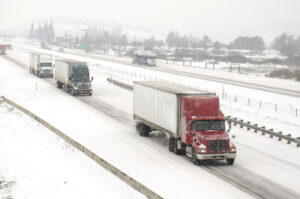Winter driving takes attention to detail and an above-average skill level, especially for truck drivers. Shifting loads, heavy trucks, and slick roads can be a deadly combination unless you are aware of the dangers and respond accordingly. These winter tips are invaluable to rookie drivers and a good reminder for veteran truck drivers.

Pre-Trip Preparation and Truck Maintenance
Winter brings unique challenges to truck maintenance. Issues that would not be problematic during warm weather are critical in freezing temperatures. Stay on top of the following issues to help you and other motorists reach your destination safely.
Complete a Hands-On Pre-Trip Truck Inspection
You should not rely on instruments to give you accurate readings. Instead, inspect tires, wiper blades, fluid, and lights before every trip. The salt that road crews use to melt icy roads can damage electrical connections, so make sure you check all electrical connections fully.
Take Time for Details
Little things make a big difference in low temperatures. Clear ice or snow from all reflective tape, signal lights, and mirrors at every stop to improve visibility for you and others on the road. As well as drain moisture from your air tanks at every stop. Keeping brake lines from freezing is imperative, especially since wind chill drives temperatures even lower when driving at highway speeds.
Prevent Freezing Diesel Fuel Lines
Since diesel fuel contains paraffin wax, this can gel in cold weather, clogging fuel lines or even damaging your engine. Keeping your tank at least half full of winter blend fuel helps prevent this problem. If the weather goes below 10 degrees Fahrenheit, run the engine every 6 hours. You should also aim for 900 – 1000 RPMs for half an hour to keep fuel fluid.
Staying Safe on Icy Roads
Although your driving habits are a key component of winter safety for truckers, you must also be aware of four-wheelers and other trucks on the road. Focus on the road ahead of you, not just your immediate surroundings. This gives you time to react if another vehicle suddenly stops or slows down or if an animal is on the edge of the road.
Avoid Traveling in Packs
Although it is tempting to use other vehicles as a frame of reference during poor visibility conditions, doing so is extremely dangerous. In this situation, your reference point is only as good as the person ahead of you.
If you are unable to see the road ahead of you but can see the tail lights of the person in front of you, you are too close. The added weight that big rigs handle means it is much harder to stop on icy roads. Finally, be aware that a vehicle’s roof full of snow can quickly turn into your windshield being covered in snow. When possible, pull ahead or drop back to give yourself plenty of space.
Do Not Slam Your Brakes
Slamming your brakes or using your Jake brake to stop on ice is a good way to jackknife a truck. The correct way to slow down will depend on the type of brake system you have. Drivers with antilock brakes should use firm, even pressure to slow down gradually. If you do not have antilock brakes, gently pump the brake pedal to slow your truck. If you feel the brakes lock, release them to keep the rig from sliding and regain control.
Know How to Get Out of a Skid
If your truck begins to skid, use these steps to regain control.
- Let off the gas and shift to neutral. Accelerating during a skid will make it worse.
- Steer into the skid. Although this seems counterintuitive, it will correct the movement of your vehicle.
- Shift to drive and gently accelerate when the vehicle corrects itself. Perform this maneuver when the rear wheels slow down but before they completely stop skidding.
Watch for Black Ice
Thin layers of matte or black ice are difficult to see on highways. Watch for spray coming from the tires of vehicles ahead of you. If it suddenly stops, there is likely a patch of black ice in that area. Use extra caution when going over an overpass or bridge. These sections of road are exposed; they freeze faster than the surrounding highways. Do not hit or tap your brakes; this could cause your truck to skid.
Be Aware of Wind Shear
Trucks have a much higher profile than smaller vehicles, which means wind shear is a bigger issue for truckers. When 40-mile-per-hour gusts whip across Midwestern plains, it can cause problems for even experienced drivers. Slow down and stay alert to navigate these sections of the road.
Handling Trucking Emergencies in Winter Weather
Being prepared for an emergency improves your chances of surviving it. Fortunately, there are several precautions you can take to stay safe in cold temperatures.
Keep an Eye on the Weather
Local weather stations can alert you about rapidly developing road conditions, but there is a better way to stay on top of potential issues. Download the Weather Channel app and sign up for real-time GPS location weather alert texts. If you have a Bluetooth headset, you can instruct your phone to read new messages aloud without risking an accident.
Keep an Emergency Kit in Your Rig
Include items like extra gloves or rain gear and a change of warm clothing in case you get wet. Non-perishable food items, blankets, and water are also essential. Your kit should also include:
- A good flashlight and extra batteries
- Sand or salt bags in case you get stuck
- Tire chains
- Jumper cables
- A windshield scraper and extra de-icing washer fluid
Stay in Your Semi-Truck if You Go Off Road
If you end up in a ditch, your truck is the safest place for you. It is easy to become disoriented when you leave your vehicle, especially in blizzard conditions. Idling your truck to stay warm can lead to carbon monoxide poisoning if you do not know how to do it safely. Keep the tailpipe clear, and run your truck no more than 10 – 15 minutes every hour. Keep a window cracked, too, preferably one that is not directly receiving wind. Use loose, layered clothing and blankets to stay warm until help arrives.
If in Doubt, Park It
You know what your rig can and cannot handle. Avoid pushing it beyond those limits. Although you may feel pressure to continue, it is better for you and your load to arrive safely. If you decide to stop, update dispatch to ensure your customers are aware of the delay, and so someone knows where you are if the weather worsens.
Most winter road safety relies on common sense, preparation, and attention to detail. Keep your rig working well, practice defensive driving, and be prepared for emergencies. Trust your instincts when making judgment calls, and stay safe out there.



 Despite COVID-19 cases still rising, the Commercial Vehicle Safety Alliance has announced that this week Brake Safety Week 2020 wi...
Despite COVID-19 cases still rising, the Commercial Vehicle Safety Alliance has announced that this week Brake Safety Week 2020 wi...

